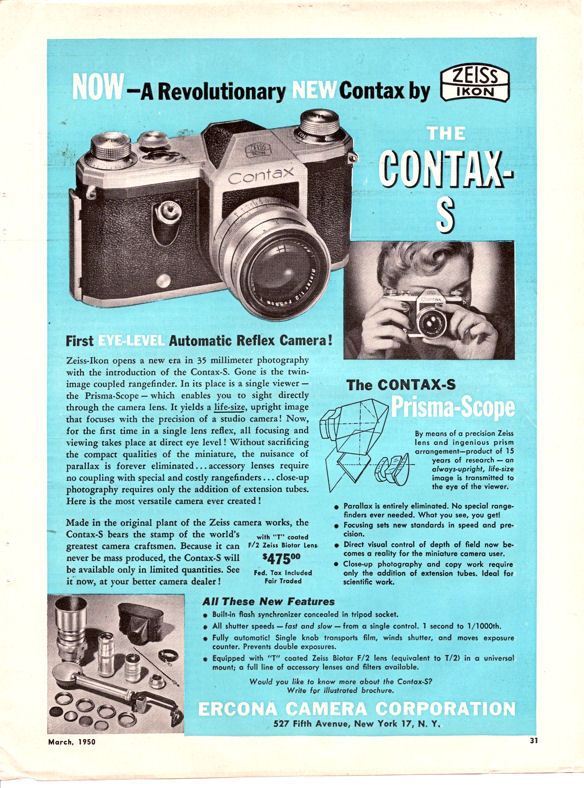- Home
- Information
- Articles
Zeiss Ikon Contax Camera Repair
A home for your Zeiss Ikon Contax, Contarex or Super Ikonta camera!
Index
The Contax II Jena Camera
This Article was last Updated on August 1, 2018.
The great collector interest in the "Jena" Contax II camera is a recent development inviting fraud and counterfeiting because this camera has become so valuable. True Jena Postar manufactured Contaxes are so extremely rare this article has been put together to protect you from being robbed. This is it's one and only purpose and I hope you also find it entertaining.
This is a picture taken recently in January 2018 in a camera shop in Japan. It is of a completely modern fake Jena Contax for sale in a case:
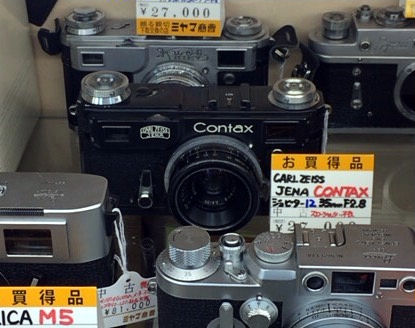
This goes to show that these modern fakes, that can easily be purchased for about $25.00 at a Moscow flea market on any weekend tend to move around and can show up anywhere. You'll notice that the clearly marked KIev right behind it is selling for exactly the same price of 27,000 Yen, which is roughly about $250.00 U.S. Dollars. The camera store operator obviously knows it is a Kiev in disguise.
The two tip off's about the most obvious Jena fakes is the Zeiss logo engraved into the left front of the face plate. I've never seen a genuine Contax with this engraving on it. The problem is that the hand drawings of Contax cameras used in some versions of the Contax II and III instruction books printed by Zeiss do show it. I'm sure this is what is causing the fakers to engrave this logo into their Kiev's with a Contax face plate on them for their victims to buy. The second tip off is the flash synch. socket that is barely visible in the photo behind the price tag. That flash socket is a Kiev identifier for sure. That flash synch . socket says there is a Kiev shutter in that camera.
In 1995, at a large camera show nearby, I purchased three black enamel Contax II bodies. These are now known to have been made in Jena for the 1951 Photokina show. The seller at the camera show thought them to be unusual and so charged me $200.00 each. But at that time no one knew anything about a "Jena" Contax and I purchased them because they were black enamel painted bodies and not because they were the "Jena" Contax. Cameras described to be "Jena" Contaxes are showing up on the Internet with extremely high asking prices, some as high as $2700.00. Because of this it seems to be a good idea to explore some post World War II Contax history to see exactly what the postwar "Jena" Contax truly is and how it is marked and identified.
There are four kinds of postwar manufactured Contax II's and a few III's:
1. There are Contax cameras assembled out of spare parts after the end of the war in Germany by Zeiss workers. Later, when parts could be made, Contaxes were made in Germany out of parts made after the end of the war but the shutters are all pre-war manufacture.. Germany experienced a severe post war famine. At least 3 million Germans died during this time due to hunger. Cameras were put together out of spare parts and sold to occupation troops to obtain dollars used to buy food. Most of these cameras were assembled very quickly out of defective parts and do not work; but they tend to look wonderful today because the were never used.
A special lens was made for these cameras that never appeared in any catalog published by Zeiss in East or West Germany before or after the war. They seem to have been made for a short time and then were discontinued. This lens demonstrates that Contax cameras were made secretly in Germany after the war and this is a picture of one of them:
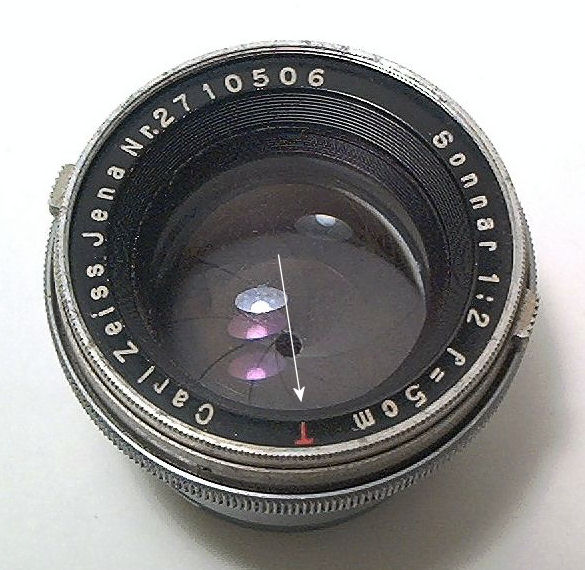
This is a postwar 50mm f2.0 T Collapsible Sonnar lens. It is marked with a Red T showing it is a first generation coated lens and so it had to be made after the end of the war in Germany. There is no point in making a lens for a camera and to not also make the camera. The russians and the Germans were not making Contaxes cooperatively and so this lens had to have been made for a German made Contax manufactured after the end of the war. There were a fair number of these lenses made. They can be found for sale on Ebay from time to time.
2. There are cameras assembled completely out of original German made Zeiss spare parts at the pseudo Zeiss assembly line set up by the russians in Kiev shortly after the end of the war. These cameras were completely made out of original German Zeiss spare parts and were assembled by Zeiss factory employees who had been kidnapped and taken to Kiev to start Contax manufacturing in russia. These can be identified but these indications are not going to be provided in this article.
3. There are completely counterfeit cameras labeled Contax made at the Kiev factory after the original Zeiss parts ran out. When production of the Contax in Kiev began there were enough original Contax spare parts to allow completely original Contaxes to be made and the quality of these cameras is extremely high. But as time went on and parts began to run out locally manufactured parts were used until the point where finally the cameras became completely russian made.
The "no name" Contax that was made without the name "Contax" engraved into the front plate is the result of the United States Government awarding the Contax trade mark, as a prize of war, to the West German Zeiss foundation that had been set up in West Germany. Once this happened the russians were forced to manufacture Contax cameras without the Contax name on them. This quickly led to the name "Kiev" being engraved in the empty spot on the face plate.
4. There is the Jena Contax manufactured in the German city of Jena by the Germans. This is the one everyone wants. These cameras were assembled completely in Germany using German made parts. But all of the original Contax shutters made before the war had been made in Dresden and the entire Zeiss complex at Dresden had been completely destroyed just before the end of the war. All of the drawings, tools, jigs and dies along with spare parts and key manufacturing personnel had all been lost. It was necessary to re-invent the Contax shutter. When this happened there were some slight and some important things lost about the pre-war shutters that did not make it into the Jena shutters. Because of this it is only possible to identify a Jena Contax by an examination of its shutter. There is no other way. I'm not going to help the fakers by listing these here.
The Germans did not make it easy to identify a Jena Contax. This is because at the same time the Jena Contax was being made the russians were making counterfeit Contaxes of their own in Kiev. Because Jena was in the russian occupied Zone of Germany it was a very dangerous thing for Germans under russian occupation to put themselves into business competition with their masters who had no love for them. This is why a genuine Jena Contax will look from the outside exactly like any other Contax. The Zeiss workers making the German Contaxes were not stupid enough to make a camera that would have resulted in many of them being put against a wall and being shot.
This is a handout given to visitors to the Carl Zeiss Jena booth at the 1950 Photokina camera show in Berlin in 1950. It shows the three Contax models that were in production at that time. Shown are the Contax IIa, the Contax II and the Contax SLR. The Contax II shown must be a Jena Contax and it apepars just like any other Contax II made before World War II.
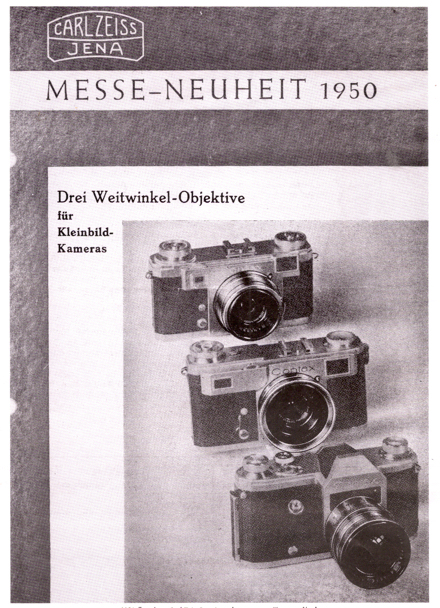
I don't want to help the counterfeiters who are working away today to rob innocent victims of thousands of dollars by specifying the exact differences between a Jena shutter and a pre-war Dresden shutter. They can find this out for themselves and will not find this information here.
The first thing for anyone contemplating the purchase of a Jena Contax must understand is that a Jena Contax looks just like any other Contax. Any camera with engravings like "Carl Zeiss Jena" in the accessory shoe, or with a flash socket on the front is a fake.
1. The first question to be answered is; Were any Contax cameras marked "Carl Zeiss Jena" ever manufactured? I am absolutely certain the answer to this question is, "No, Never, Ever". These cameras are actually modern Kiev fakes with false engravings. This answer is explained, demonstrated and justified in the following:
2. The "Carl Zeiss Jena" trademark only came into being after 1957. Both the Zeiss remnant in East Germany and the newly formed Zeiss in West Germany were fighting over the very valuable "Carl Zeiss" and "Zeiss Ikon" trademarks so they were both using them at the same time. In 1957 the United States awarded both trademarks to the newly formed Zeiss Foundation that had been established in the U.S. Occupied Zone of Germany. The U.S. had seized these as prizes of war and owned them. In 1957 the ownership of these trademarks and the validity of them being given to the West Germany Zeiss company was decided by the U.S. Supreme Court. This is what forced the East German Zeiss company to add "Jena" to the Carl Zeiss trademark in 1957 because the court decision prohibited Carl Zeiss labeled items made in East Germany from being imported into any western country.
3. The third question that needs to be answered is what is the time period during which the Contax II and III cameras, manufactured in Jena after the end of World War II, actually manufactured? There is some recently available old evidence allowing for this period to be determined. It is late 1947 to 1951:
4. The fourth question is were Contax cameras manufactured at locations other than Jena after the end of World War II? This question will be answered first.
Immediately as the war ended Germans were starving. Hitler had engaged in a deliberate program to punish the German people for the war defeat and had ordered his armed forces to destroy all civilian infrastructure, transport and food stocks. When the war ended workers at Zeiss manufactured cameras out of spare parts and sold them to American occupation forces for dollars so that they could purchase food for themselves and their families. These Contax I, II and III cameras are not Jena Contaxes. They are immediate post war Contaxes. The Zeiss workers, just like anyone else in their position immediately prior to the end of the war had to know that the war was lost and that they would have to fend for themselves for a while. Just like anyone else would do they took the things, like camera parts and lenses, and hid them so that when the war would be over they would be able to support themselves during the very bad times to come. Over three million Germans starved during the three years of famine following the war as a result of Hitler's program of revenge on the German population.
The Russians confiscated 92% of the equipment, machines and tools and certainly 100% of the spare parts from the Zeiss factory at Jena as war reparations. Before doing this they forced the workers there to fabricate a Contax II/III assembly line including all necessary jigs, dies and special tools. This was all disassembled and shipped to Kiev along with about 300 experienced Zeiss Contax workers. They also took all of the Contax spare parts they could find. Once the Contax assembly line was set up in Kiev the first thing the Russians did was to use genuine German spare parts to assemble Contax II and III cameras. It is almost impossible to tell these apart from Genuine German made Contaxes except for the use of certain Russian made parts and materials in them.
The very rare Chrome face Contax I is a postwar camera. The reason for this is that prior to World War II Zeiss had obtained all of the special black lacquer paint used on the Contax 1 from Russia. Once the Germans made war on Russia this supply of paint was cut off and it was not available until sometime after the end of the war. This explains the chrome plating on the front faces of these extremely rare cameras. The chrome face Contax 1 is the rarest of all the postwar Contax cameras.
There are two sources of Contax I, II and III cameras manufactured immediately after the end of World War II. What makes the Jena Contax distinguishable from these is the design of the shutter. The Russians had taken everything Contax to Kiev, including all the experienced Contax workers, and so the Germans in Jena had to re-invent the Contax shutter. In doing this they could not include several improvements that had been made to the shutter immediately prior to the end of the war. A genuine Jena Contax has a Jena design shutter in it.
This is a picture of a part of the Zeiss Jena factory dated 7/10/47 that is typical of the general condition of the entire Jena works at this time. it demonstrates how complete the russians had been in cleaning the place out. This picture is marked to be a United States Navy official photograph. As you can see the factory is empty. This is explained by a press release pasted to the back of the picture.
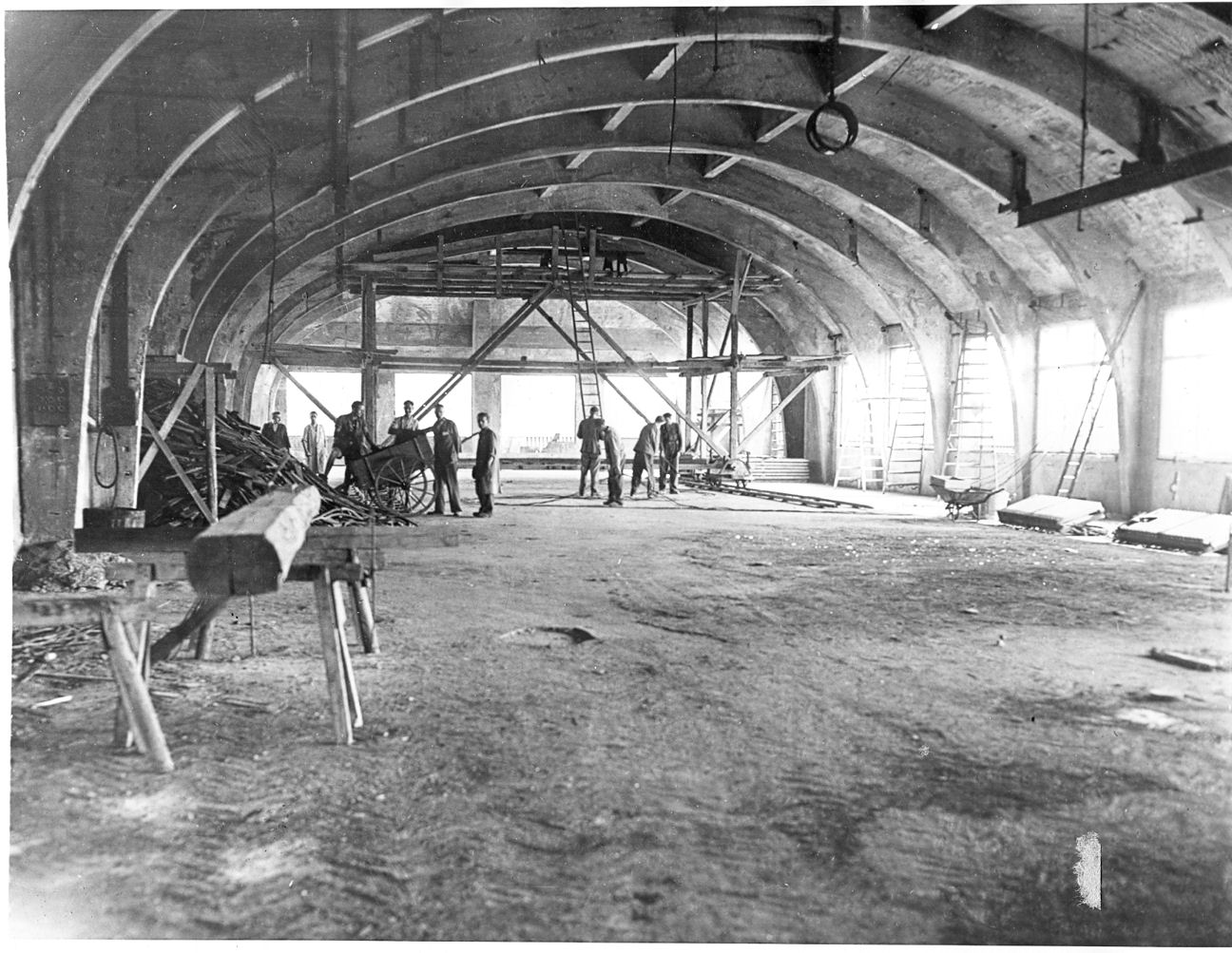
This press release reads as follows:
ZEISS LENS WORKS RESUMES OUTPUT
One wing of the Zeiss plant which was damaged and subsequently dismantled. Workmen are strengthening the structure so that it can be put to use when additional facilities become available.
ZEISS GERMANY - Efforts are being made to get the famed Carl Zeiss Works, located in the Russian-Occupied Zone of Germany, back into production of camera lenses with the use of old machinery brought from other parts of the country. The plant has been out of production since late in 1946 when the Russians removed 94 percent of its machinery and shipped it to the Soviet Union as reparations. The Russians who promised to leave enough machinery to form the nucleus around which production for civilian needs could be built, did leave about 700 to 800 machines of a total of 10,000. A plant machine shop was able to rebuild other old machines so the Germans now have 1,000 in working condition. With 5,000 employees the plant expects to get into limited production of camera lenses sometime in July 1947.
My belief is that the first priority for the Carl Zeiss Jena works was to get into a positron where the pre-war Contax camera and its lenses could be manufactured. The Contax was a cash cow generator of foreign exchange prior to the war and so it's a good bet they wanted it back into production as soon as possible. The fact the Contax II and IIi were being manufactured and available for sale around July 1947 is illustrated by advertising produced by the Peerless Camera Company in 1947.
This is a picture of the 1947 Peerless Camera Store Spring to Summer Photographic Catalog. This catalog is 74 pages long and so it is not duplicated in its entirety here. But it contains no mention of any German made camera except for the Leica iIIc and it is described to be a "brand new" model. This demonstrates that at the time of production of this catalog, very likely April 1947, there were no Contaxes being officially imported into the USA and none from other sources were available.
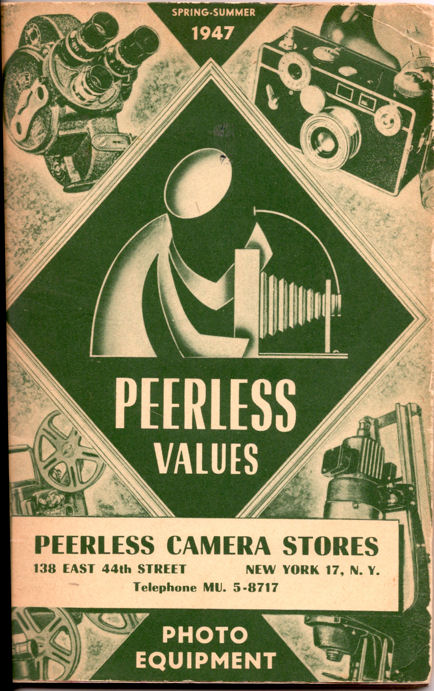 .
.
This is the first page of this catalog. It demonstrates that In 1947 Peerless was a huge New York camera store. If anyone had been able to get a newly manufactured Contax at that time it would have been them. They would have been very glad to get them. If you would like to see just how rotten the assortment of 35mm cameras available in 1947 was you can use this link to view the two pages of 35mm cameras available in this catalog. The recovery from the effects of World War II on consumer goods took a lot longer than people know today and these two pages clearly show this:
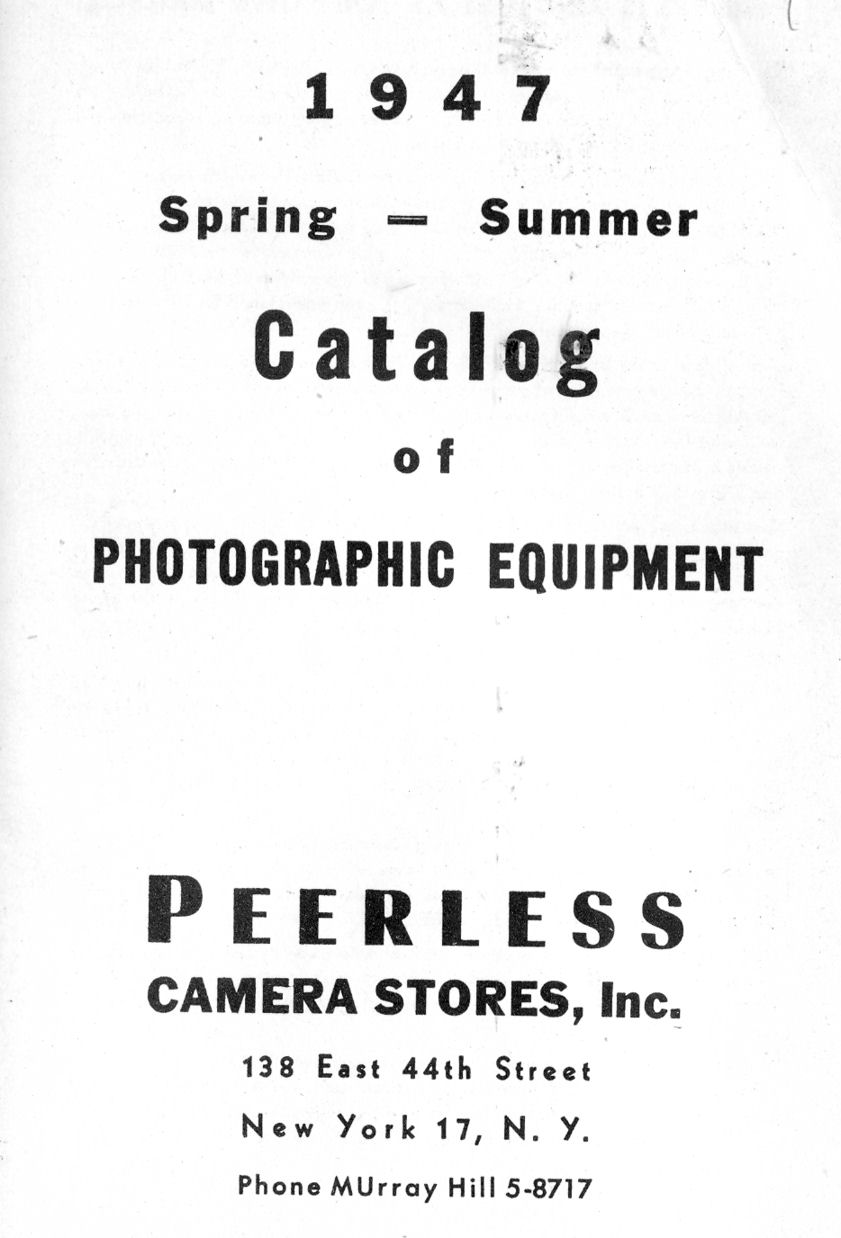
But later in the same year the Contax II and the Contax III appear in a Peerless newspaper advertisement::
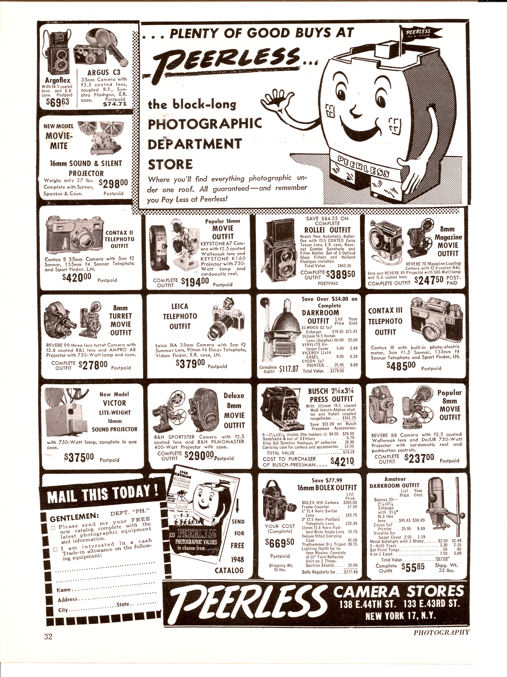
Here's a close up of the Contax II part of this advertisement:
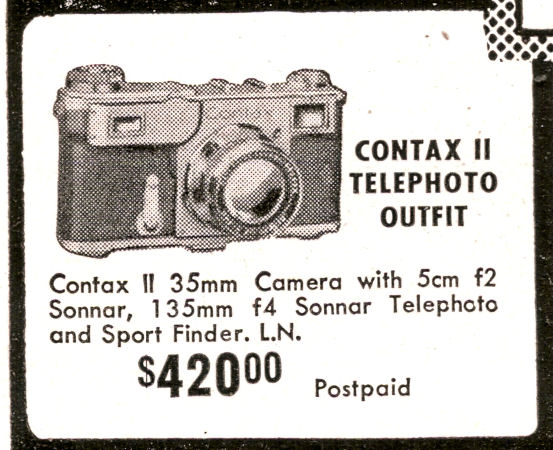
Here is a close up of the Contax III part of this advertisement:
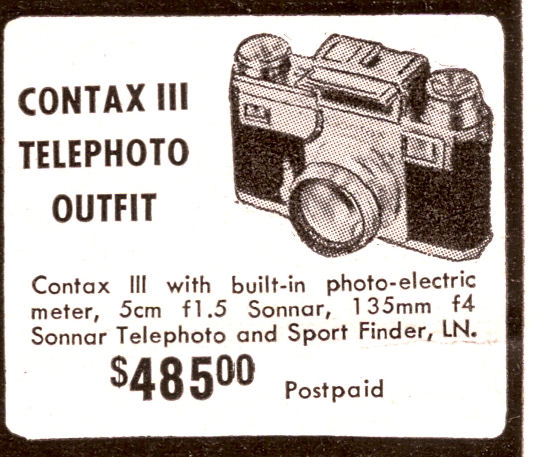
Notice that the pictures of the Contax II and III appearing in these advertisements show the pre-war version of the Contax. Both cameras are identical outfits with both described to be Like New "L.N.". Both are being sold for new prices. In 1947 Contax cameras, lenses and accessories were being imported into the USA by German immigrants. Germany was impoverished at that time. There was no hard currency in Germany except for the dollars being spent by occupation servicemen. Germans immigrating to the USA knew the way to survive in the USA was to bring a new camera with them and then sell it once they arrived in New York City. A Contax could be purchased for German marks in Germany at that time. The Germans coming here after the war knew to do this because it was common knowledge in Germany to do this before the war. Before the war the German government stripped emigres of all their money and properly except they were allowed to take a camera with them. People leaving Germany to move to the USA before the war would buy a new Contax and as many lenses and accessories as they could get to take with them and sell here upon arrival. These two identical new outfits are doubtless newly arrived from Germany in the luggage of recent German immigrants to the USA. If they were used they would have been sold for roughly half the new price,or about $230.00. These were unofficially imported new cameras recently manufactured in Germany.
The official appearance of the Contax imported into the USA by Zeiss Ikon is demonstrated by a copy of the official Zeiss Ikon "Jena" Contax Instruction book. This is the 1948 Contax II and III Instruction Book produced after the war. This is a copy of the front page showing the 1948 date:
If you want to view the entire Contax Jena Instruction book you can use this link to a complete copy available for free download:
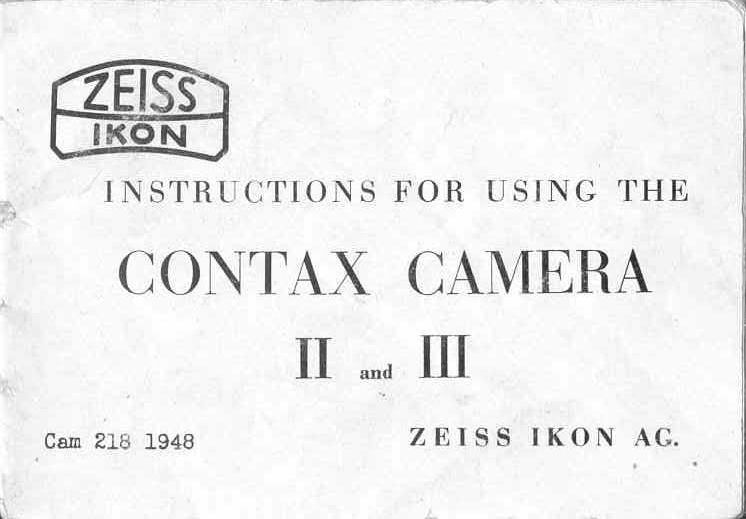
There are a some very important bits of information on this cover. The first is it identifies "Zeiss Ikon AG.", the pre-war name of Carl Zeiss. It is not marked "Carl Zeiss Jena". But, in 1948 the only Zeiss factory remaining in Germany capable of manufacturing a Contax was in Jena. This book demonstrates that Zeiss, in it's immediate post war condition, was using the "Zeiss Ikon" trademark on the Contax. This is an instruction book for a postwar German Zeiss manufactured Contax, a true "Jena" Contax. It also shows that this book is for Camera No. 218. This demonstrates that the Contax cameras being made at that time were not being made in large numbers as before the war. This book also shows that in 1948 everyone at Zeiss believed that the process of postwar reconstruction of Germany would proceed so that Carl Zeiss A.G. would continue just as it had before the war. No one understood that future political developments in Germany would result in two separate Germanys with two separate Carl Zeiss companies; Carl Zeiss VEB later Carl Zeiss Jena in East Germany and Carl Zeiss in West Germany. This instruction book and the Peerless newspaper advertisements also demonstrate there was a Jena Contax III in addition to the Contax II.
The question of the earliest time when a Jena Contax could be made is answered by a book that Carl Zeiss Jena published in 1959. Here is the cover of the book:
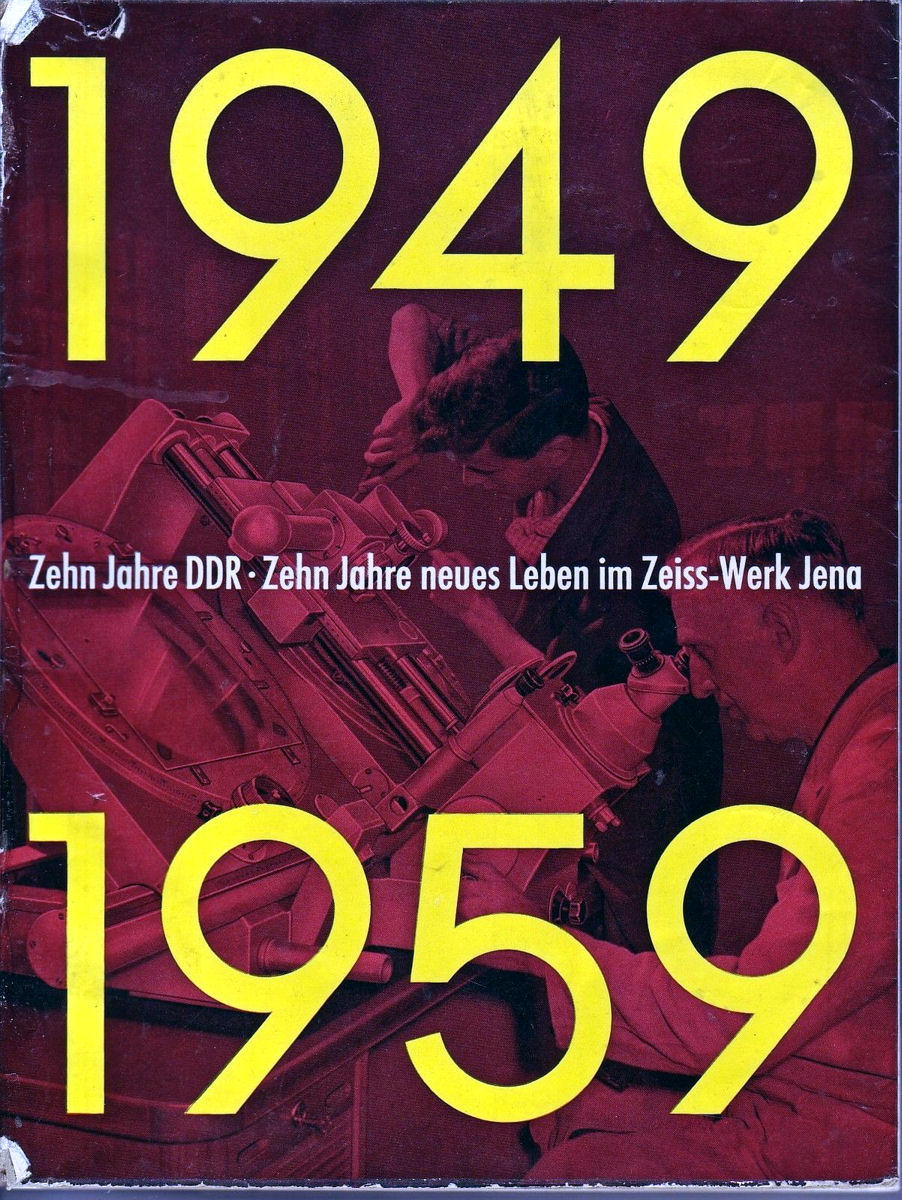
This book face shows that Carl Zeiss "Jena" as a separate entity distinct from "Carl Zeiss" in West Germany began it's existence in 1949. All Contax cameras manufactured between the end of World War II in 1945 and the establishment of Carl Zeiss Jena in 1949 were postwar manufactured cameras. These postwar cameras had two sources: They were made simultaneously in Russia using Zeiss tools, spare parts and kidnapped Zeiss workers at the factory set up in Kiev or they were made in Germany using parts that had been hidden. Both the Kiev factory and the Zeiss factories used pre-war Dresden made spare parts to manufacture Contaxes between 1945 and 1949. The manufacture of the new shutter used in the Jena Contax could not have taken place until the Zeiss works in Jena had been sufficiently reconstructed after being looted by the Russians in 1946.
The Postwar manufactured Contax SLR Camera, the Contax D, provides all of the trade marks used by the East German Zeiss company. This is the company that manufactured the "Jena Contax". These Contax D SLR cameras allow us to see all of the different trade marks used by Carl Zeiss Jena on it's line of Contax cameras from the time of the end of World War II in 1945 up until 1952.
This is the earliest known advertisement for the first modern Single Lens Reflex camera, the post war manufactured Contax S model camera. This advertisement is from the March 1950 issue of Popular Photography. Notice the Contax S is clearly marked "Zeiss Ikon" and not Carl Zeiss Jena. Yet, the advertisement clearly states the camera is manufactured in the "original Zeiss camera works". This is the same place the postwar Contax II and III would have been made. If you'd like to see a larger scan of this advertisement just click on it. There's a lot of very interesting information in it.
The Contax-S camera was imported into the U.S. by the "Ercona Camera Corporation". This company was established in the U.S. to import cameras and lenses, including the Contax II and III, marked with the Carl Zeiss trademark that had been manufactured in the Russian Occupied Zone of Germany (Jena) into the United States. It was put out of business in 1957 when the Carl Zeiss trademark was officially awarded by court order to the Zeiss Foundation that had been established in the U.S.A. Zone of Occupation. After the court decision in 1957 any Contax II or III manufactured in Germany was forbidden entry into the USA. This coincided with the production of the Contax IIa and IIIa manufactured in Stuttgart in the U.S. A. Zone of Occupation. This court order was also responsible for the famous "no name" Contax which was really a Kiev in disguise manufactured in Russia. The "No Name" Contax demonstrates that prior to 1957 fake Contaxes were manufactured in Russia and sold in the U.S.A. Just how many of these there ar no one knows. Use this link to upload the court order:
1957 Court Decision Carl Zeiss to West Germany
This is a picture of the prism cover of a Zeiss Contax D SLR camera manufactured very shortly the establishment of the two separate Zeiss companies, probably close to the 1957 - 1958 time period. "VEB" is the East German designation for a corporation and "GMBH" is the West German designation. This camera demonstrates two things. The first is that this is THE Contax manufactured after WWII in Jena. The second is that any Contax II or III camera made after the war in Jena during this time period; and this would have to have happened prior to 1951, would have been marked "Zeiss Ikon" and not "Carl Zeiss Jena". This camera also has high quality German made naturally tanned leather on it. This tells me that any camera, made in Germany after the war, did not have Russian oil tanned leather on it.
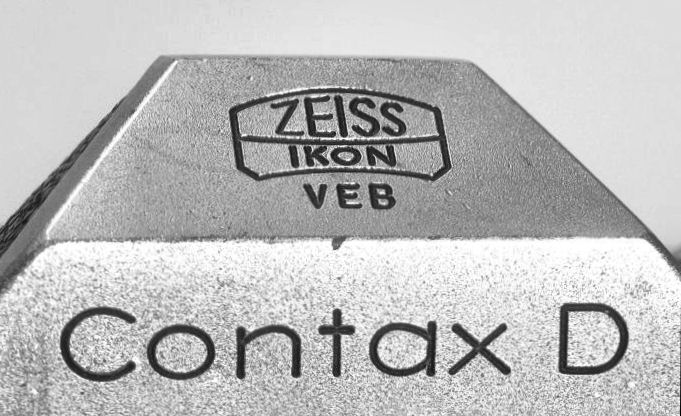
This is a picture of another Contax D Top plate, manufactured in the 1958 time period showing the trademark used for a very short while by the East German Zeiss company in Jena. It shows the Zeiss Ikon Tower in Jena along with "ZI" to abbreviate "Zeiss Ikon". At the time this camera was made a fierce court dispute between the two competing West and Eastern German claimants to the very valuable "Carl Zeiss" and "Zeiss Ikon" trademarks had been settled. Carl Zeiss in Jena lost this fight and so rather than use the Zeiss Ikon trademark, that they could only use illegally, they used the abbreviation "ZI". This top plate also shows this camera was attempted to be brought into the USA because the "Contax" trademark has been ground out of it and then this was later covered with a leather covering that has since fallen off. It was the practice of USA Customs to deface the name or trade mark on any item that was attempted to be imported out of a communist state into the USA that was marked with a name or trade mark registered to a company existing in the USA. Notice the "ZI" standing for "Zeiss Ikon" logo. Both East and West German Zeiss companies were fighting over this trademark at the time this camera was made.
![]()
This is a picture of the bomb smashed Carl Zeiss Jena Complex in 1945. Shortly after this picture was taken the Russians cleaned it out of all its machinery, spare parts and materials. It is easy to see why it took two years, until 1947, before Contax cameras were being made there and why they were being made in small numbers:
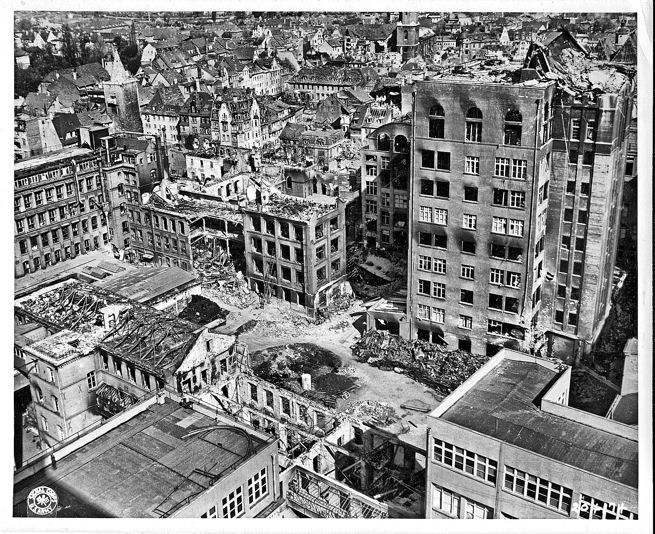
The 1948 Instruction book contains several important pictures of the postwar Contax camera:
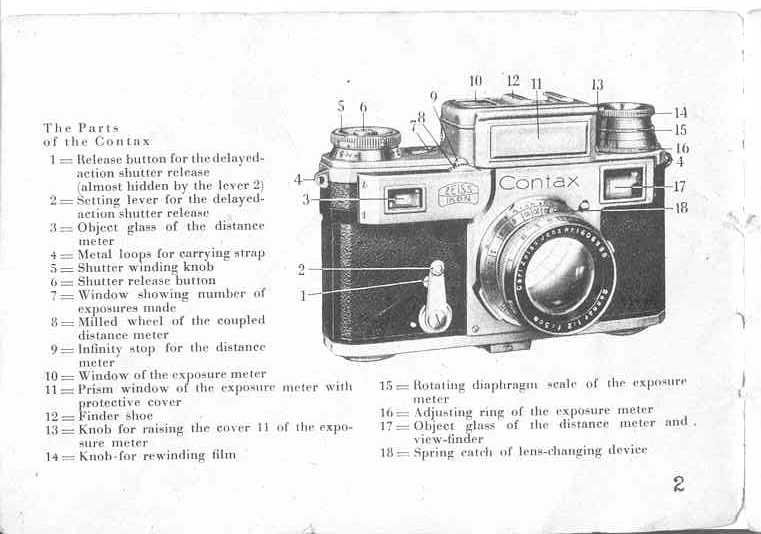
As you can plainly see this is not a dressed up Kiev with a far too obvious "Carl Zeiss Jena" engraved in the accessory shoe. It is a normal pre-war Contax II but with one exception. There is a very obvious "Zeiss Ikon" engraved on the front plate. I believe that only this camera, used to make photographs for this post war instruction book, was so engraved. The purpose of this engraving is to demonstrate that this camera is NOT being made in Russia. Immediately after the war the Russians moved in and cleaned out the Zeiss factories in their zone of occupation that included the Jena Zeiss Works. They also had the Zeiss workers in Jena manufacture for them a complete set of jigs, dies and tools to be used to manufacture the Contax camera. The Russians also took about 300 Zeiss Worker slaves to Russia to manufacture the Contax camera in Russia. These very early Russian made Contaxes are very high quality being made by German workers, on German made tools, using German made Contax spare parts and materials taken from Germany and put together in Russia. In 1948 this Instruction Book demonstrates that the Russians were making Contaxes and the Germans were making Contaxes at the same time and Germans knew it was necessary to illustrate the fact the cameras being sold under the Zeiss Ikon name were actually made in Germany. I have seen Russian made Contaxes and have here in my personal collection a Contax III that appears German made in every way except that the photocell has Russian Cyrillic writing on it and a 1948 manufacture date. The Germans at Zeiss in Germany clearly wanted to show that they were making Contaxes in Germany in Jena in 1948. The Zeiss Ikon front engraving on this camera also demonstrates this instruction book was produced entirely after the war.
The Instruction Book also contains another important picture:
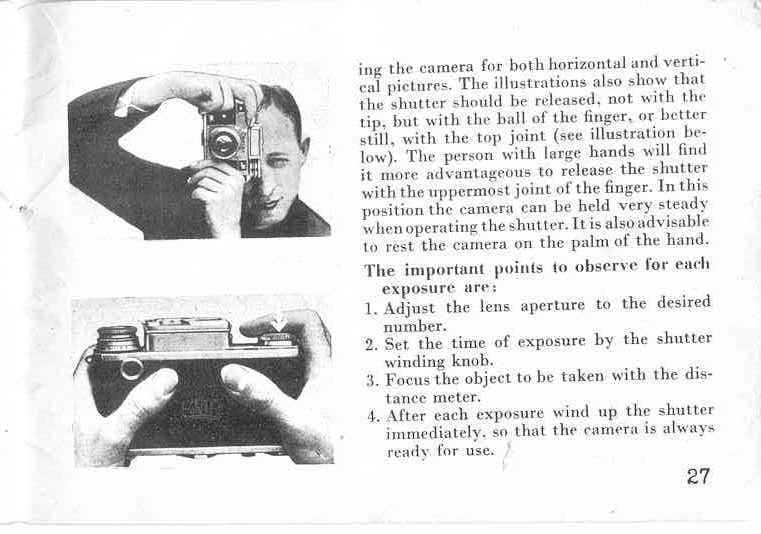
Notice the bottom picture on this page clearly shows that the back leather on this camera has the official "Zeiss Ikon" embossment. In 1948 Russia had two sources of leather to use on their Contaxes. These were locally produced leather and Zeiss factory spare parts. The reason genuine Zeiss leather is so good is it is completely naturally tanned using natural tree bark extracts. This is the highest quality leather there is. The Russians did not tan leather by this method. They used an oil based process. The problem with oil tanned leather is it cannot take an embossment because it cannot be wet and will not absorb water whereas natural tanned leather will absorb water. The embossment process requires wetting the leather before it is pressed into the embossing die because without the wetting the embossment will not be permanent and will slowly fade away and become ugly. This explains why the Russian made Kiev camera back leather is not embossed. This also explains why the dressed up Kiev's with the excessively convenient "Carl Zeiss Jena" engraved into the accessory shoe do not have the "Zeiss Ikon" embossment on the back leather. These fake "Jena" Contaxes have Russian made leather on them because they were made in Russia and started out life as Kiev's.
This is a Contax IIa camera advertisement from June 1952 Note is does not say the Contax IIa is better than the Contax II. It says the Contax IIa is the Contax, the only Contax. The Contax IIa was introduced at the 1951 Photokina Photography Show in Germany. The Contax IIa was produced by Carl Zeiss in West Germany in Stuttgart. The East German Zeiss Jena VEB also produced a small number of black enamel painted Contax II bodies to demonstrate at the same camera show. The strange thing is the Contax IIa used lenses made in Jena at that time. This has introduced some confusion. But the Contax IIa was such a huge improvement the Contax II was effectively killed off at the 1951 Photokina show and none were produced after it. There was just no point in making the old style Contax II because no one wanted it or would buy it. There was another reason not to make it and this because the Russians were also making cameras labeled to be Contax at that time. The Russian Contax was cheaper than the German made one and no one could see any difference between them. The only reason the East Germans would make a Contax II would be to sell it in the West for dollars, and the Contax IIa had filled that market niche perfectly. The Contax IIa put any plan to re introduce the Contax II to death. This means that all available evidence shows the genuine "Jena" post war Contax II and III was manufactured in Germany only in very small numbers between 1947 and ending in 1951.
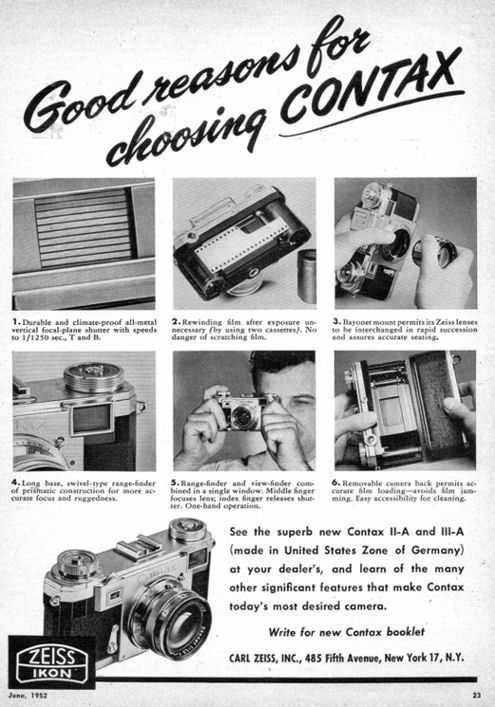
The big question is how is a genuine German made postwar "Jena" Contax manufactured between 1947 and 1951 identified? The answer is it can only be done through an examination of the shutter. The reason for this is that Zeiss made incremental improvement changes to the shutter during its time of manufacture in Germany from 1936 to 1944. These improvements resulted from problems experienced by owners whose cameras required factory service. The shutter design was "reconstructed" from memory by Zeiss after the war but all of the most experienced Contax workers had been taken to Russia. This resulted in several of these improvements being not included in the postwar shutters that were made in Germany starting in 1947. There is also an improvement made to the postwar German made shutter that was not included in the pre war shutter. I am not going to identify this here because to do so would only assist the counterfeiters who are at work today manufacturing fake Jena Contaxes.
This is a front view picture of a genuine postwar manufactured "Jena" Contax II. It was purchased by an American soldier stationed in Germany after the war. He purchased it as a new camera in a camera shop there. It was brought back to the USA by him and then kept as his most prized possession until it was passed on to his son who sent it here for an overhaul. It is truly a postwar manufactured "Jena" Contax II.
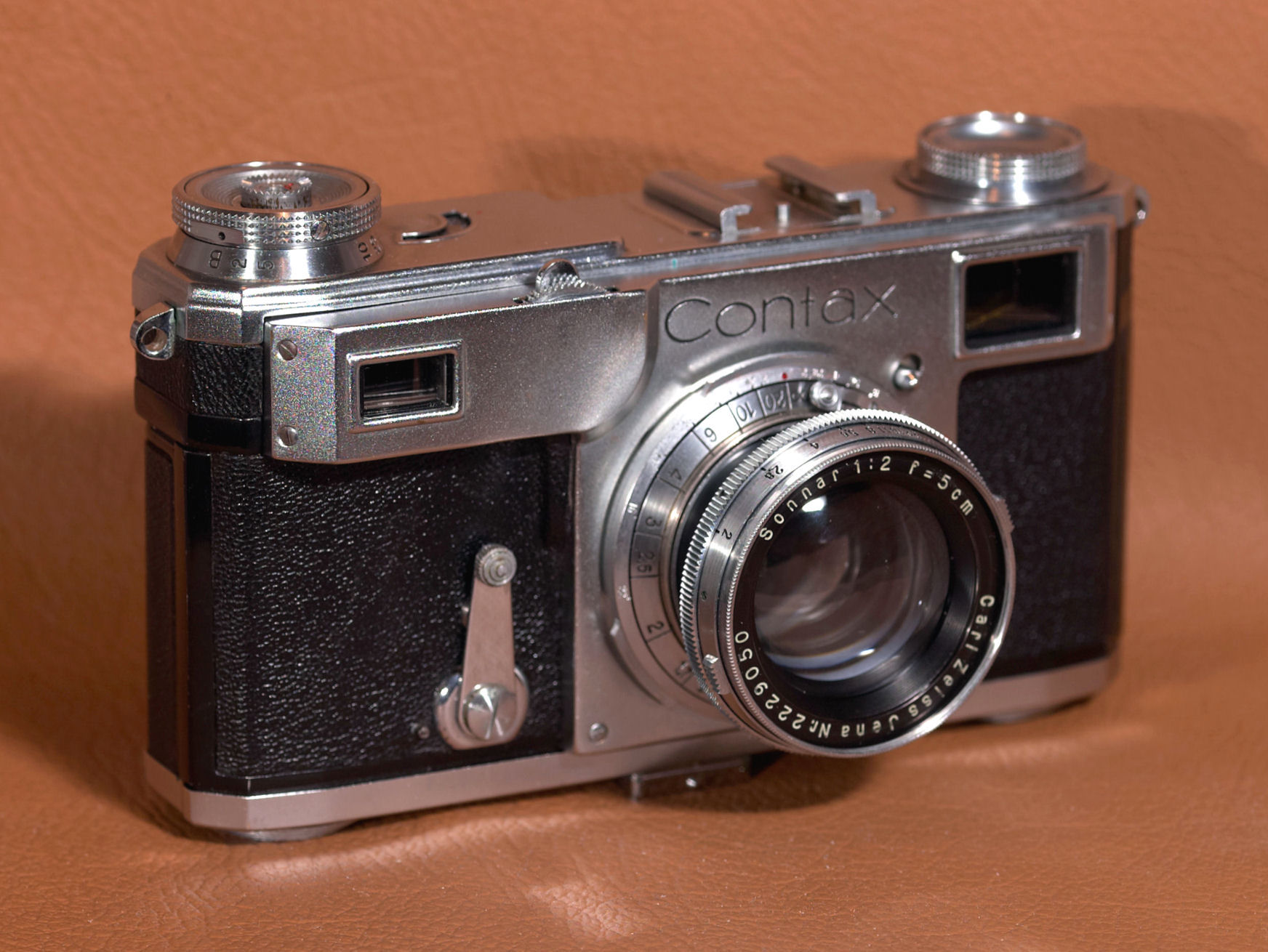
Here is the rear view showing the "Zeiss Ikon" embossment:
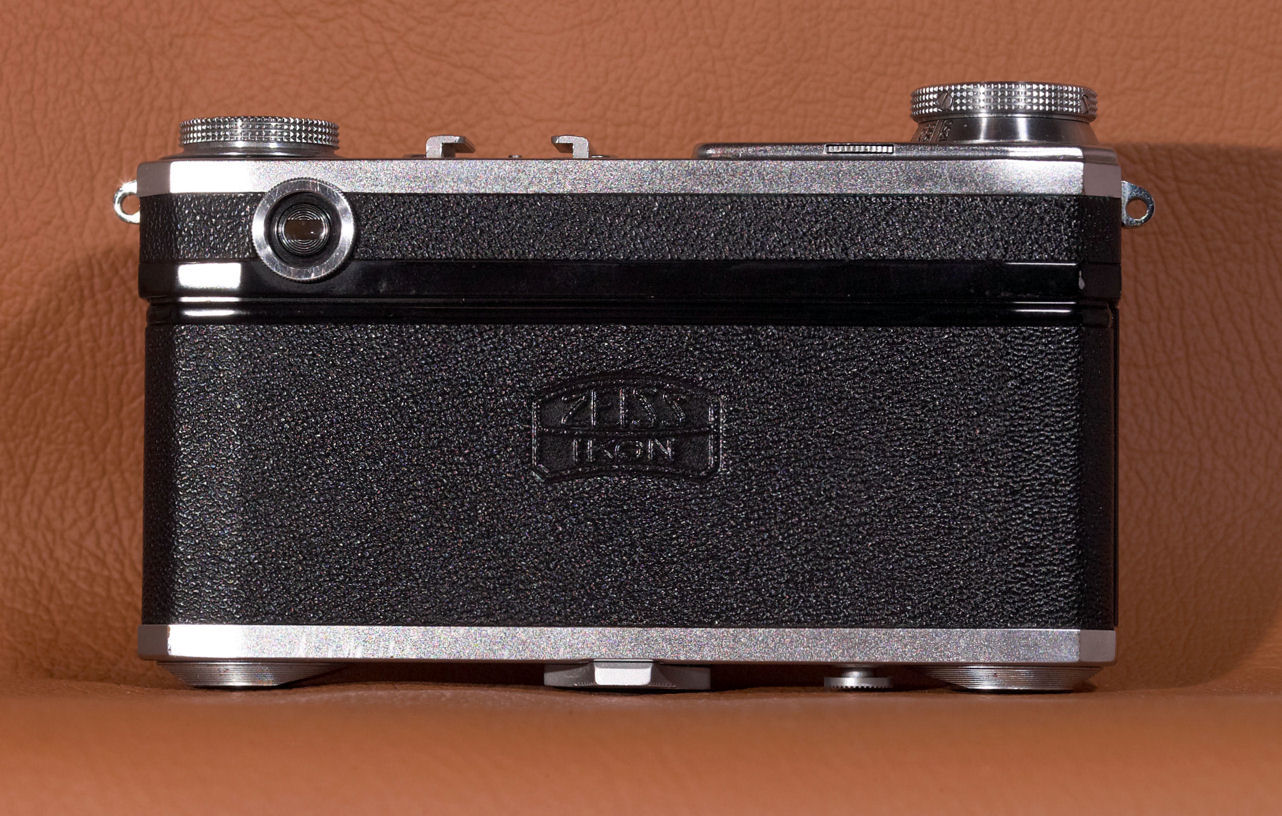
Here is a picture of the bottom of this camera:
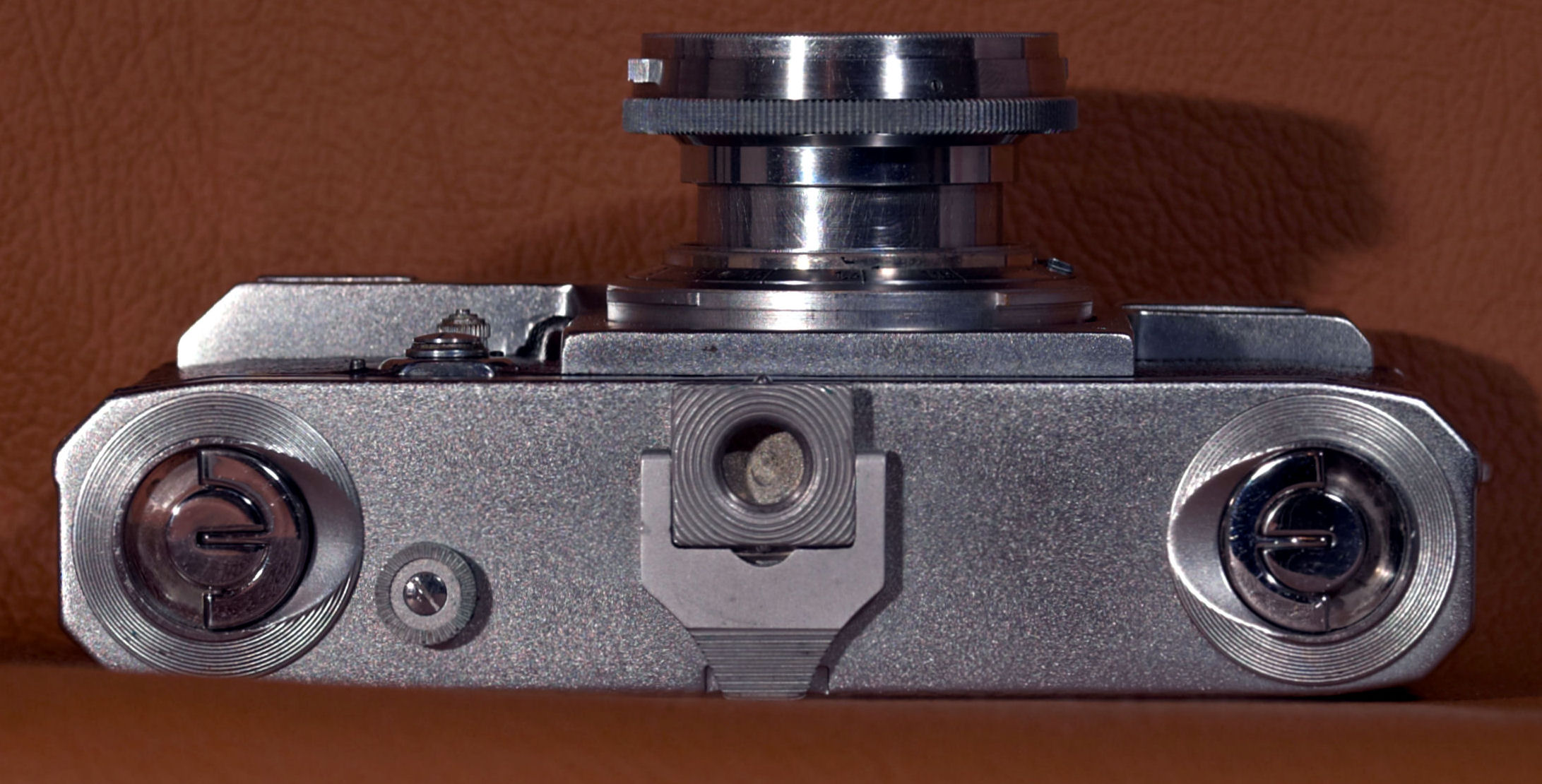
As you can see. It looks exactly like a Contax II in every way except that this one is absolutely MINT perfect.
This is a picture of the top of a Kiev fake Contax II. The "Carl Zeiss Jena" that should be "Zeiss Ikon VEB" is just far too convenient and it is just plain wrong for the time period. To put it simply, the Carl Zeiss Jena engraving in the accessory shoe of this camera is a fairy tale designed to deceive and allow a $25.00 camera to be sold for thousands of dollars. These fakes are being manufactured today and the sellers are asking very high prices for them. If you see one you'll notice another thing about them. They all look brand new just like this one. There is not a single tiny use mark on any of them. They all look like they just came out of the box and I'm sure they are all very newly manufactured in Kiev or the Ukraine.
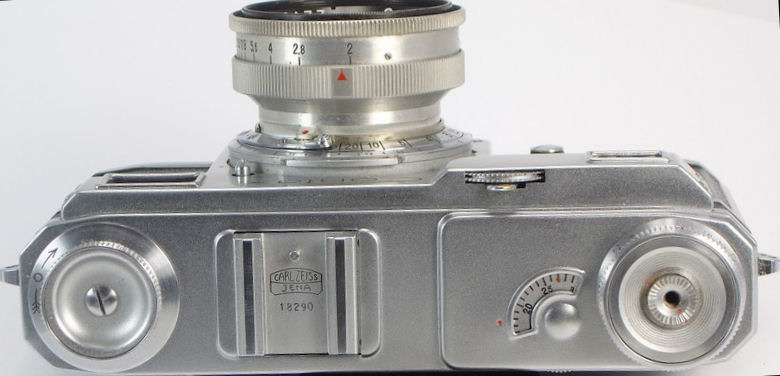
This is a picture of the back leather of the same camera:
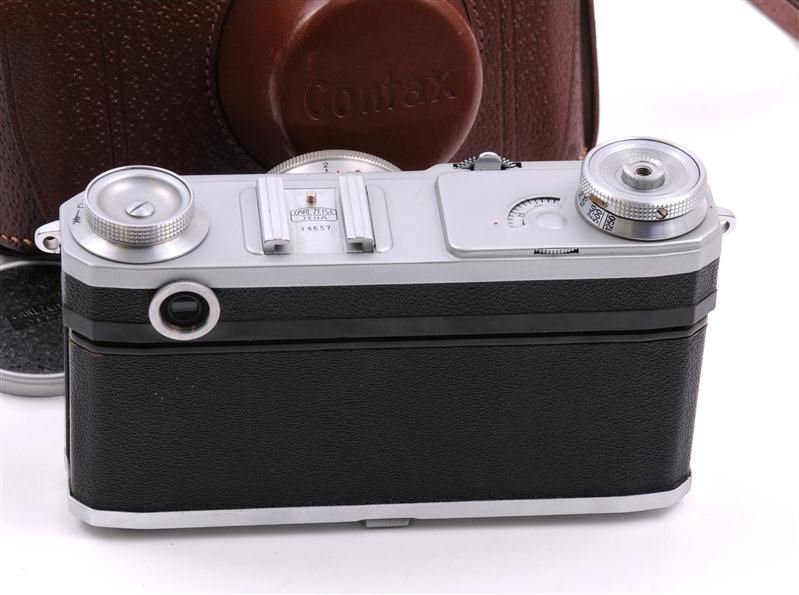
As you can see there is no "Zeiss Ikon" embossment. This camera has Russian leather on it. The reason for this is that there are many different ways of tanning leather. Some tanning methods are fast and some are slow. Original Zeiss Contax leather is tanned using the best and slowest method and it is the highest quality leather ever made. Tanning Zeiss leather takes about a year. It will accept an embossment pressed into it with a metal die. The Russians used oil tanned leather. This method tans the leather quickly. This leather will not accept an embossment because the particular type of oil used to tan it makes the leather too springy.
One of these fake Contaxes was sent to me for an overhaul. It had a Kiev shutter in it. The Kiev shutter in it was not an early Kiev shutter it was a late one. Late Kiev shutters have a little flash synchronization circuit board installed in it. This board has a switch and it is riveted into the shutter. The shutter in the camera I examined contained this board but the wires to it had been cut. This demonstrated this was a russian made camera using relatively recently manufactured components.
This fake Contax does have a very prominent post war Contax lens on it. This is, of course, part of the sales presentation because it just wouldn't be any good to have a Russian Jupiter lens on it. There are a great many of this particular lens model available in very high cosmetic quality on the market today. The reason for this is that while the Contax IIa body was made in West Germany, this lens was made in East Germany in Jena. Zeiss West initially used Jena lenses on the Contax IIa because lenses were not yet being made in West Germany. But as soon as lenses could be made there the Zeiss Opton and Carl Zeiss lenses West German made lenses were supplied with the Contax IIa and the Jena lenses were no longer provided with the Contax IIa and IIIa cameras. But Zeiss Jena did not stop making their versions of the Contax lens. The Jena 50mm f2.0 Sonnar was manufactured for a very long time. This is demonstrated by the 1954 Zeiss Jena lens catalog.
This is the cover of the East Germany VEB lens catalog from 1954:
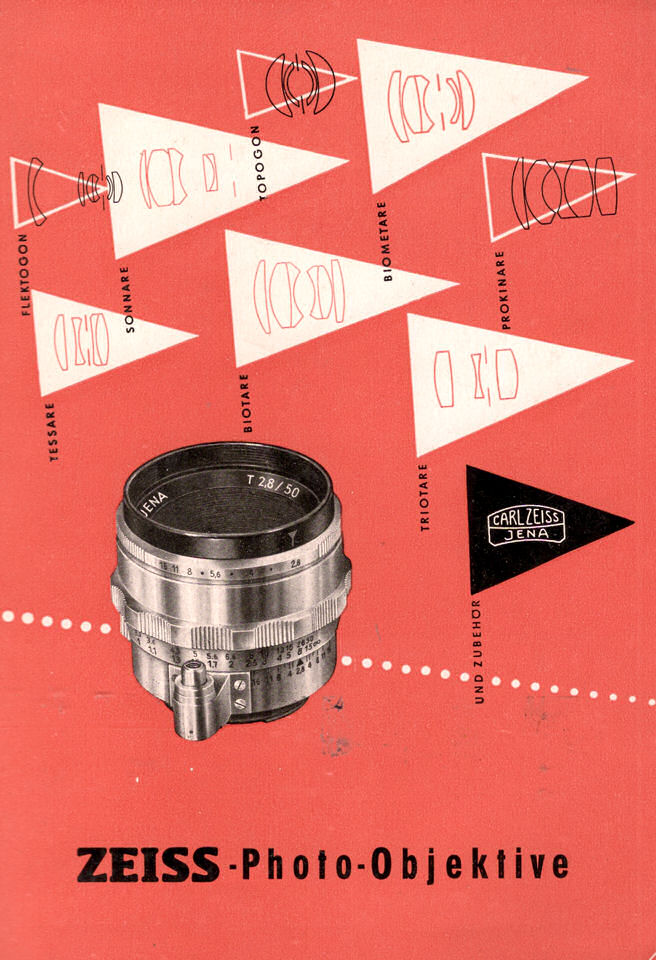
While this document is in German it is easy to see from the Sonnar page that in 1954 Carl Zeiss Jena was manufacturing 50mm f2.0 and 1.5 Sonnar lenses for the Contax:

Notice that this catalog, produced by Carl Zeiss Jena VEB, does not specifically identify a "different" postwar Contax II. The catalog states the Sonnar lenses are for the Contax I through III and the Contax IIa and IIIa. Many of these lenses were produced and sold. They were not made specifically for the Contax IIa and IIIa. The 50mm f2.0 T marked Carl Zeiss Jena Sonnar is abundant today. At the end of World War II there was a very great demand for coated lenses. This demand was so great that for a short time it was possible to send pre war manufactured Zeiss lenses back to Zeiss in Germany to be coated. The main point is the 50mm T coated Carl Zeiss Jena Sonnar that appears on the fake dressed up Kiev's marked "Carl Zeiss Jena" are readily available today because a great many of them were made.
Here is the front page from the 1951 Contax IIa Brochure announcing the new Contax IIa::
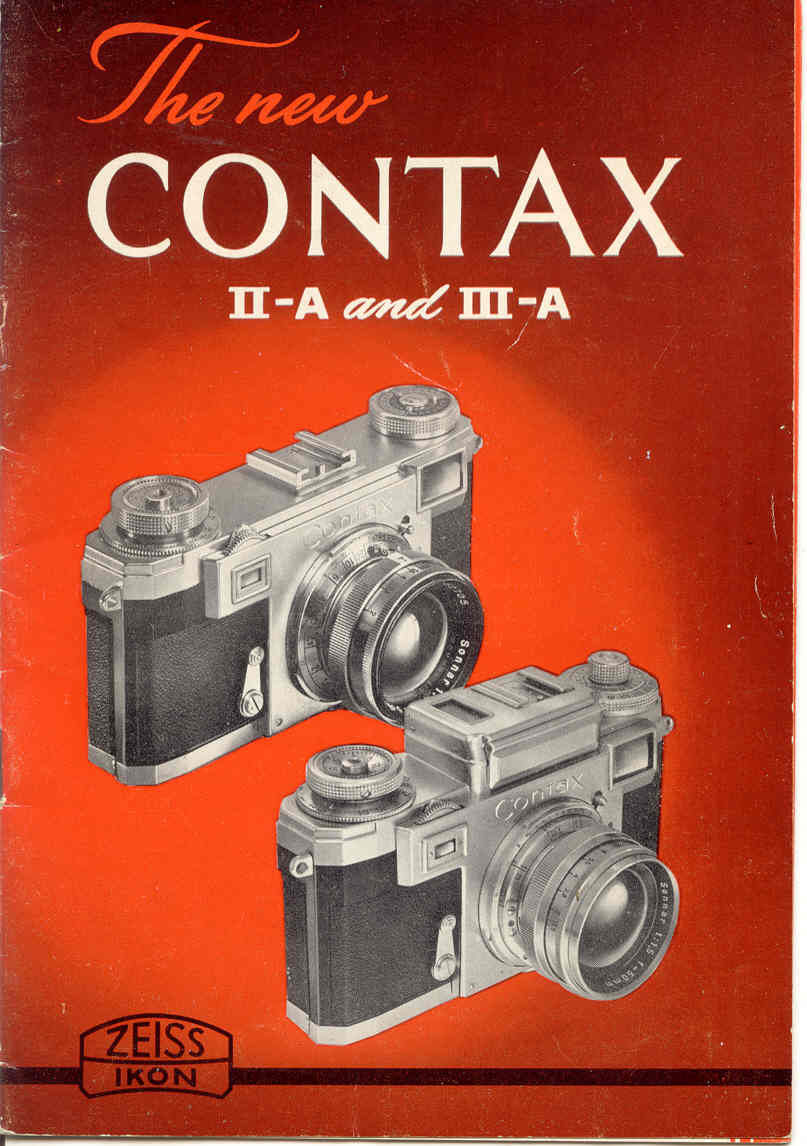
Notice the Contax IIa has a 50mm f2.0 Jena lens on it.
If you want to view a complete copy of this brochure please use this link to a complete copy available for free download:
This is an illustration from this brochure showing the Jena made and labeled 50mm f2.0 Sonnar lens. You can see the "Jena" just visible:

Finally, just to demonstrate the Russians are very actively manufacturing Contax fakes today here is a picture of a fake Contax that was sold out of the Ukraine recently. It's quite a monster being labeled "Contax", with a "Zeiss Ikon" lens cap, and a black paint body. This camera is a true fraud designed to deceive and it is not the only one there is. There are lots of these. The Russians are manufacturing every conceivable version of fake "Contax" and selling them these days. If they can manufacture this then they can manufacture anything, including a Kiev labeled "Carl Zeiss Jena"
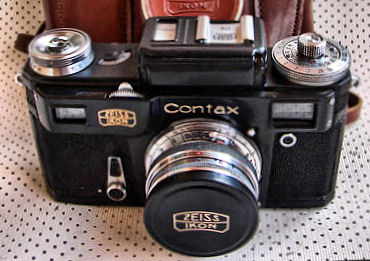
The reason the flash synch. socket is so important is the russians modified the design of the Contax shutter to include a plate with a switch on it to provide good flash synchronization. This plate is permanently mounted on the side of the shutter and makes the shutter about 2mm wider than a Genuine German made Contax shutter. The flash synch. socket you can see in this picture is positioned exactly over this little plate and so it has to be where it is. It cannot be anywhere else on the camera. The Russian designed self-timer lever along with the later Contax IIIa style light meter control knob are also huge "tells". I once saw a fake Jena Contax with a Kiev shutter stuffed into a Genuine Contax body with the wires cut on the switch plate.
The one and only way to identify a true postwar Jena manufactured Contax is through a very careful examination of its shutter. The Russians are pumping out every kind of fake Contax based upon the Kiev. These are being sold all over the world and I'm certain China is stuffed full of them.
Don't you be their next victim. I see about one genuine Jena Contax here about every 20 years or so. They are extremely rare. And to tell you the truth I sorely wish I'd kept that mint one shown in this article.
If you've made it all the way down to here and you'd like to send me a comment about this article or know something that would help me with it, I'd love to hear what you have to say. Here's an email link:
If this link won't work for you my email address is Superwide@earthlink.net.
If you are a maker or seller of fake Jena Contaxes please don't bother to write. I've seen your postings and know all about what you think of this article.
